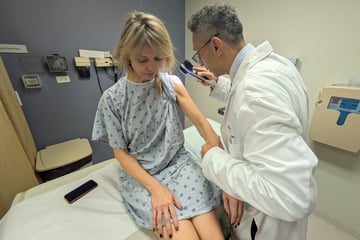Fungus-fueled bat crisis linked to the death of 1300 children in the US
Scientists have linked the death of bats due to a lethal fungus to steep increases in infant mortality across the US. The study found that pesticide use played a role in the increase in child deaths.

When a deadly fungus, suitably called "Pseudogymnaoscus Destructans," migrated to the US from Europe, bat colonies in North America quickly started to decline.
The fungus' name was particularly descriptive, as the fungus creeps its way into bat colonies when they are hibernating in winter. Also known as "White-nose syndrome," it sprouts up as little white bits of fuzz on their noses and can destroy an entire bat colony.
In a study published in Science last week, scientists revealed an unlikely link between the brutal destruction of the US bat populations and a steep increase in the average infant mortality rate, as well as the death of 1300 children.
Due to the fact that bats prey on agricultural insect pests, the US has faced increasing problems with crops that would have otherwise been protected.
The study suggests that the subsequent use of pesticides to compensate for the lack of bats is likely to be the cause of economic problems as well as health costs linked to child mortality.
"County-level insecticide use and infant mortality due to internal causes both increased after the emergence of white-nose syndrome, whereas farms' crop revenue decreased," said Bianca Lopez, associate editor at Science, in the article's summary.
In the study's introduction, author Eyal G. Frank stated that he validated "Previous theoretical predictions that farmers respond by substituting bats with insecticides."
"Because those are toxic compounds, by design, this substitution leads to higher human infant mortality rates in the areas affected by the bat die-offs," he wrote.
"I find that farmers compensated for bat decline by increasing their insecticide use by 31.1%. The compensatory increase in insecticide use by farmers adversely affected health – human infant mortality increased by 7.9% in counties that experienced bat die-offs."
But isn't the problem the pesticides, not the bats?

It is at this point that many may start asking why the focus has been placed on the decrease in bat populations, rather than the pesticides themselves, as the link to the 7.1% increase in infant mortality rates.
Environmental economist Charles Taylor, from the Harvard Kennedy School, addressed this very issue when talking to The Guardian.
He said, "A lot of papers that try to link pesticides to outcomes are correlational in nature."
"People who are exposed to more pesticides, for example, might have other risk factors – like, farmworkers are exposed to a whole host of other socioeconomic risks that could explain why there might be different health outcomes."
The bat die-offs, however, offered an ad-hoc randomized control trial, Taylor explained. This was because the spread of white-nose syndrome was monitored closely, and thorough data existed that could compare counties with the highest bat losses to child mortality rates.
"The bat disease wasn't expected, and it shouldn't have preferentially targeted certain groups over others," said Taylor.
That doesn't mean, however, that pesticides, farmers, and the chemical manufacturers don't have a level of responsibility.
"We're dumping these synthetic materials into our environment, not knowing anything about what their impacts are going to be," Columbia professor David Rosner told The Guardian.
"It's not surprising – it's just kind of shocking that we discover it every year."
Cover photo: Unsplash/2H Media
